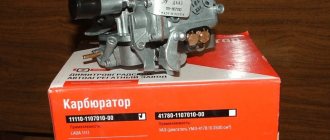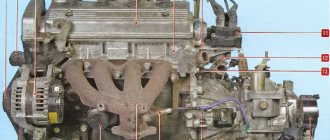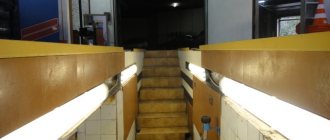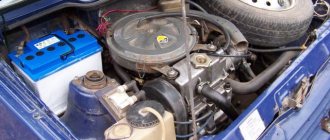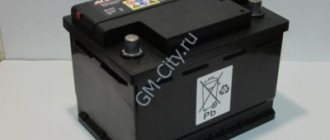The VAZ 1111 engine is a development of a domestic automaker, which was installed in the Oka car. The exact displacement of this power unit is 649 cubic centimeters. At the same time, the engine is capable of producing maximum power up to 30 horsepower.
Manufacturers were able to achieve such indicators thanks to two cylinders, each of which has 4 valves. The engine was powered by a carburetor. And if we’re not talking quite seriously, then the manufacturers simply sawed off half of everyone’s favorite engine installed under the hood of the VAZ-2108.
Specifications
| Engine capacity, cc | 649 |
| Maximum power, hp | 30 |
| Maximum torque, N*m (kg*m) at rpm. | 44 (4) / 3400 |
| Fuel used | Gasoline AI-92 |
| Fuel consumption, l/100 km | 4.7 |
| engine's type | In-line, 2-cylinder |
| Add. engine information | Carburetor, overhead valve timing system with overhead camshaft |
| Maximum power, hp (kW) at rpm | 30 (22) / 5600 |
| Cylinder diameter, mm | 76 |
| Piston stroke, mm | 71 |
| Number of valves per cylinder | 2 |
Production history
Mass production of VAZ-1111 "Kama" cars (almost a copy of the produced "Oka") was planned in the Tatarstan city of Elabuga on the Kama River at the Elabuga Passenger Car Plant (ElAZ), which in 1988 was part of the ideological military-industrial complex and increased production Consumer goods were repurposed by the failed Kama Tractor Technical Plant, under the pretext of a decreased national economic and military-strategic need for tractors and tanks. Equal in scale to AvtoVAZ, ElAZ was supposed to produce 900 thousand VAZ-1111 cars per year, its employees and their families were supposed to sharply increase the population of Yelabuga to 300-400 thousand people, and from the new residential areas of Yelabuga to the industrial site of the plant and to Naberezhnye Chelny should The light rail was about to be launched. Due to the liquidation of the planned socialist economy and then the collapse of the USSR, ElAZ was later implemented not in its intended form, but as a small-scale licensed production of foreign cars, while production of the VAZ-1111 was established on a smaller scale at other car factories.
After the transition to market pricing and payments in foreign currency, the Volzhsky Automobile Plant considered the production of 20 thousand cheap small cars per year economically unprofitable. Therefore, in 1995, production of the VAZ-1111 “Oka” model was completely transferred to Serpukhov to SeAZ (formerly SMZ) and to Naberezhnye Chelny to ZMA (the passenger car division of KamAZ, now the Sollers plant). Around the same time, a 0.75-liter 2-cylinder 33-horsepower engine was developed to replace the 0.65-liter 29.7-horsepower engine. The new 33-horsepower VAZ-11113 engine was also a “half” of the more powerful and high-torque 1.5-liter VAZ-21083 engine.
At the end of 1998, after the default and sharp devaluation of the ruble, the Oka microcar turned out to be one of the cheapest four-wheeled vehicles in the world, which sharply boosted its popularity in the domestic and foreign markets. Until 2005, ZMA and SeAZ constantly increased production of the only Russian model of the “A” segment, but later the demand for the obsolete Oka began to fall due to the revaluation of the ruble and the import of more modern cars (primarily the Uzbek Daewoo Matiz and Chinese analogues). In addition, VAZ curtailed engine production for the Oka, considering it unprofitable to further adapt it to Euro-2 standards introduced in Russia since 2006, which required replacing a cheap carburetor with an expensive injection system and using a catalytic converter in the exhaust system.
SeAZ-11116-50 van.
In 2006, production of Oka at ZMA was discontinued due to the purchase of this enterprise (now Sollers). At the remaining only SeAZ, in 2006, production of its modification SeAZ-11116 with an imported Chinese 3-cylinder 1.0-liter injection engine (licensed engine from Daihatsu Charade G10) was launched, and in 2007 an attempt was made to produce (only a pilot industrial batch) of pickups and vans of the SeAZ-11116-50 subfamily, and a reinforced version of the SeAZ-11116-60 pickup, semi-frame design, with a load capacity of 400 kg, was developed. Soon after this, SeAZ stopped producing cars with Russian engines, completely switching to a Chinese unit.
Over the years of production, the Oka was regularly modernized: the instrument panel, the heating and ventilation system of the body, as well as some body parts, primarily the plastic body kit, including the radiator grille and bumpers, were repeatedly changed. Larger wheels began to be used (13″ instead of 12″). The Chinese 3-cylinder engine installed on the SeAZ-11116 develops one and a half times more power (53 hp versus 33 hp) with significantly less noise and vibration, which, together with a 5-speed gearbox, improved acceleration dynamics and increased the maximum speed , and also ensured compliance with environmental standards Euro-2, and since January 2008 - Euro-3.
In November 2008, SeAZ stopped production of Oka due to its unprofitability. By the end of the year, the remaining commercial vehicles were sold, and since March 2009, SeAZ has been in a state of conservation and sold off excess equipment, but at the same time maintains a number of vital workshops, for example, electroplating, in working order. In 2013, AvtoVAZ announced its intention to revive Oka, but things did not go further than statements.
Peculiarities
The VAZ 1111 Oka engine works on such a principle that its entire process occurs in just two revolutions of the crankshaft. This allows the power unit not to experience heavy loads in the form of vibrations. But if such problems arise, then in order to compensate for them, manufacturers have installed two balancing shafts aimed at reducing vibrations.
The supply of the fuel mixture is controlled using a carburetor. The lubrication system is created by installing a gear pump, which makes it possible to take engine oil from the crankcase and deliver it to the friction pairs of the camshaft and crankshaft. In this case, the cylinders are irrigated by the formation of oil mist during operation, and the gas distribution mechanism and valve curtains are lubricated by gravity.
The weight of the VAZ 1111 engine is only 66.5 kilograms without clutch and gearbox. Therefore, its power is quite enough to achieve normal acceleration rates for the car under the hood of which it is installed.
The cylinder head is made of aluminum, which allows for a relatively small mass of the power unit, while the block itself is made of cast iron. The gas distribution mechanism is driven by a belt.
The cylinder diameter is 76 millimeters, and the piston stroke is 71 millimeters. Thanks to this combination, it is possible to obtain a compression ratio of 9.9 to one.
VAZ 1113 engine structure
1 — oil pan; 2 - balance shaft; 3 — cylinder block; 4 — oil receiver; 5 — cover of the first main bearing; 6 - oil pump; 7 — generator drive pulley; 8 - crankshaft; 9 — timing belt of the camshaft drive; 10 — toothed pulley of the coolant pump; 11 — oil filter; 12 — tension roller; 13 - camshaft; 14 — camshaft gear pulley: 15 — cylinder head cover; 16 — filler neck cover; 17-camshaft bearing housing; 18 — fuel pump; 19 — housing of auxiliary units; 20 — eccentric for driving the fuel pump; 21 — spark moment sensor; 22 — adjusting washer; 23 — valve pusher; 24 — valve guide; 25 - valve; 26 — valve seat; 27 — coolant temperature indicator sensor; 28 - piston; 29 — connecting rod; 30 — oil level indicator; 31 - flywheel; 32 — drive gear of the balancing shafts; 33 — balance shaft gear; 34 — crankshaft rear oil seal holder.
Advantages
Since the engine capacity of the VAZ 1111 is only 649 cubic centimeters, which is achieved with just two cylinders, there is practically no need to talk about positive qualities. If you pull your ears, you can give a few examples:
- Ease of maintenance and availability of spare parts. Since this engine is in fact half of a 1.3 liter VAZ 2108 engine, all spare parts are interchangeable.
- Small expense. But this is only a subjective concept, since a motor with such a volume cannot burn a large amount of fuel in principle.
Small KAMAZ
Engine D 243: technical characteristics
Although the development of the small car was carried out in Serpukhov, it was supposed to be launched into mass production in Elabuga, and since the city is located on the Kama River, the model was given the name “Kama” VAZ 1111. But due to the unstable economy at that time Back in the Soviet Union, the plans were not destined to come true - the production of the brand in the planned volume (900 thousand cars per year) did not work out, and the Elabuga plant was repurposed. VAZ-1111 began to be produced in smaller volumes, and at other enterprises:
- at the Volzhsky Automobile Plant in Tolyatti;
- in Serpukhov (SeAZ);
- in Naberezhnye Chelny (ZMA).
In Togliatti, the production of a small car did not last long - its production on the main AvtoVAZ conveyor was unprofitable, and in 1995 the Oka was removed from the assembly line. The small car plant (ZMA) in Naberezhnye Chelny produced Oka until 2005, and the letters “KAMAZ” were proudly displayed on the nameplates of small cars.
Problems
Despite the small number of advantages, problems with this engine occur quite often. But this is not surprising, since the characteristics of the VAZ 1111 engine clearly contribute to this. Among the main negative qualities are the following:
- When the timing belt breaks, the valve bends. Unlike its brother VAZ 11113, the valve mechanism fails and often comes into contact with the pistons, so you need to monitor the belt very carefully.
- The balancing shaft gears are made of textolite, which is a rather soft material. This entails that after a short mileage they simply break.
- The cooling system of the power unit brings a lot of problems to owners of cars with such an engine. But everything is caused not by the fact that it is not sufficiently developed, but by the fact that the details in it are not of sufficient quality.
- Under the hood of the car, strange sounds are constantly heard, the cause of which is unadjusted valves. Despite all the apparent seriousness, this can be fixed very easily, even on your own in the garage.
- The cylinder head gasket is of very poor quality, so it can break through literally after a few kilometers.
- The ignition system is poorly protected from moisture, so driving a car with such an engine under the hood in rainy weather is highly not recommended.
- The carburetor can throw out its whims, so the engine often begins to work unstably, and sometimes even “troubles”.
Reliability, weaknesses, maintainability
Reliability
Despite its small size and weak points, car owners consider the VAZ-1111 a reliable, economical and unpretentious engine. Numerous reviews are clear confirmation of what has been said.
For example, Vladimir writes: “... mileage 83,400 km... satisfied, no problems. At -25 it starts easily. I change the oil every 5-6 thousand km...”
Dmitry: “... the engine is reliable and unpretentious. During the time I used it I never climbed into it. It spins quite vigorously. The dynamics are not bad, especially for me, a lover of calm and careful driving. If necessary, the car accelerates to 120 km/h. Fuel consumption is low. On 10 liters in the city you can travel an average of 160-170 km...”
Most car enthusiasts note that engine breakdowns do not occur often, mainly due to the driver’s oversight. Constant attention to the engine - and there will be no problems. You can read about this in almost every review.
Of course, there are also negative statements. An example of such a review from NEMO: “... an eternally dying switch and twin coil, an overflowing carburetor, whose needles are consumables, but starting at -42 in a parking lot is confident...”. But there are only a few such (negative) reviews.
When upgrading an engine, designers place the reliability factor at the forefront. So, after another modification, the crankshaft and camshafts became more reliable.
The mileage declared by the manufacturer also indicates the reliability of the engine.
Weak spots
Despite the reduction in engine dimensions, it was not possible to avoid weak points.
Vibration. Despite constructive attempts (installation of balance shafts, a special crankshaft), it was not possible to completely eliminate this phenomenon on the engine. The main reason for the increased vibration is the two-cylinder design of the unit.
Often, car enthusiasts are concerned about the inability to start the engine “hot”. Here, in most cases, the fault is placed on the fuel pump, or more precisely on its problematic diaphragm.
For a successful start, you need to wait some time (until the pump cools down or, in extreme cases, put a wet rag on it). It is advisable to replace the pump diaphragm.
Possibility of overheating. Occurs due to the water pump or thermostat. Low quality components, and sometimes careless assembly, are the basis for the failure of these components.
The car owner can only monitor the coolant temperature more carefully and replace faulty components as soon as possible.
Knocks in the engine compartment when the engine is running. The reason must be sought in unregulated valves.
In addition, when the engine warms up after starting it, the balance shafts usually knock. This is a design feature of the motor that you will have to get used to.
Burnout of the cylinder head gasket. This may occur due to a manufacturing defect associated with installation or due to incorrect (incomplete) tightening of the head fastening.
For the VAZ-11113 engine, an additional weak point is failures in the operation of electronics, especially sensors. The problem can only be solved by a car service center.
Maintenance
Manufacturers claim that under conditions of modern use and proper maintenance, the VAZ 1111 engine has a service life of 120 thousand kilometers. Therefore, despite the large number of malfunctions, these units can be considered quite reliable, especially considering their category.
The main thing is to undergo maintenance on time, the scheduled period of which is 15 thousand kilometers. Maintenance involves changing the oil, and you need to use synthetic oils, and if you fill in semi-synthetic, then it needs to be changed every 10 thousand kilometers. Also, do not forget that it is necessary to flush the oil system and replace the corresponding filter. When choosing which oil to pour into the VAZ 1111 Oka engine, you need to know that it includes 2.5 liters of lubricant marked 5W-30.
Every 30 thousand mileage it is necessary to adjust the engine valve clearances. But unfortunately, everyone turns to the service or carries out this operation on their own only when necessary. At the same mileage, it is recommended to clean the carburetor and adjust the idle speed.
After 60 thousand mileage, it is necessary to replace the coolant, because if this is not done on time, the substance will begin to lose its lubricating properties, which will lead to a decrease in the service life of the system. With the same mileage, it is imperative to replace the timing belt.
Posts 1 page 17 of 17
Share March 227, 2010 21:52:41
There are no dimensions in the OKE primer, I can measure them in a car, but I can’t vouch for the accuracy. I am posting a photo from the book, please explain what dimensions you are interested in. Where I will measure the length. I can only try it on Monday.
Share March 327, 2010 21:59:28
Yes, without swearing, RADICAL - already got it. I’ve already changed my computer (though not because of him), and I’ve changed my password, just like in that joke: “I brought the toilet and showed my ass, but they still didn’t sell toilet paper.” I'm sorry, but I'm running out of nerves. I can't post a photo.
Share March 428, 2010 19:43:07
Thanks in advance! Length: from the timing case to the gearbox. Width; at the outermost points without an air filter. Height; from the bottom of the pan to the top of the valve cover and from the pillow to the top of the valve cover.
Share March 629, 2010 15:49:31
From the timing case to the clutch casing - 3 cm, from the timing case to the box (including the clutch casing) - 13 cm. Width - 55 cm. Height from the bottom of the pan to the top of the valve cover 60 cm + 1.5 cm oil filler neck. Height from the center of the cushion to the top of the valve cover 38 cm + 1.5 cm oil filler neck (size from the center of the cushion under the generator)
"Oka"-11116
At the last stage of production, the small car began to be equipped with a Chinese-made power unit, which somewhat “revitalized” the car, but did not save it from curtailing production.
The Chinese installation was three-cylinder, with a total volume of 1.0 liters. Its power rating was 53 hp. With. This motor was already equipped with an injection power system.
Also, Oka with this engine received a 5-speed. Manual transmission.
How to disassemble a VAZ Oka engine
Engine.
Transmission.
The clutch is single-disk, with a diaphragm spring, the clutch release drive is cable, with a backlash-free installation of the clutch release bearing. Gearbox – 4-speed, with synchronizers in forward gears. Send numbers: I – 3.7, II – 2.06, III – 1.27, IV – 0.90, 3X – 3.67. Main gear – cylindrical, helical, gear. number – 4.54. The wheels are driven by shafts with constant velocity joints.
Wheels and tires.
Suspension.
Brakes.
Steering.
Electrical equipment.
Filling volumes and recommended operating materials.
Fuel tank - 30 l, AI-93 gasoline. Cooling system – 4.8 l. antifreeze A-40;
Engine lubrication system – 2.5 l. Oils used: M-6/10G, at temperatures from plus 20 to minus 25 degrees C; M-6/12G, at temperatures from plus 45 to minus 20 degrees C; M-5/10G, at temperatures from plus 30 to minus 30 degrees C;
Gearbox housing - 1.8 l, see engine oils;
Hydraulic brake system - 0.55 l, Neva, Tom, Rosa fluids; Hydraulic struts for front suspension 2×0.27 l, MGP-10; Rear shock absorbers 2×0.143 l. MGP-10; Windshield washer reservoir – 2.0 l, NIISS-4 liquid and mixtures with water.
Tuning
No matter how funny it may sound, owners of cars with such engines sometimes customize them a little. Most often, a VAZ 11113 injector is made, installing a power supply system from the VAZ-21083i power unit. But this is very expensive and also takes a lot of effort. If we take into account all the costs, it is easier to install the Chinese TJ376QE power unit under the hood of the car, which produces power. And you can even screw a small turbine there, at your own peril and risk.
Piston dimensions
Defects of engine parts
When replacing parts of the connecting rod and piston group, it is necessary to select pistons to cylinders by diameter and weight, as well as piston pins to pistons by diameter and connecting rods by weight.
The following data is stamped on the piston bottom:
1
- piston class by pin hole (1, 2, 3)
2
- piston class by diameter (A, B, C, D, E)
3
- arrow showing the direction of installation of the piston
4
- weight group (normal - “G” , increased by 5 g - “+”, decreased by 5 g - “-“)
5
- repair size (diameter increased by 0.4 mm - D, by 0.8 - E)
The cylinder class (A, B, C, D, E) is stamped on the bottom plane of the block (the mating plane under the oil sump).
For the convenience of selecting pistons to cylinders by diameter, both are divided into five classes: A, B, C, D, E (every 0.1 mm). Spare parts include pistons of nominal sizes of three classes A, C, E and two repair sizes. The first repair size is increased by 0.4 mm, the second - by 0.8 mm.
Based on weight, pistons are divided into three groups: normal, increased by 5 g and decreased by 5 g. Pistons of the same group must be installed on the engine.
For repair size pistons, spare parts include repair size rings increased by 0.4 and 0.8 mm. The number “40” is stamped on the rings of the first repair size, and “80” on the second.
Nominal sizes of cylinder and pistons diameters, mm
When selecting pistons for cylinders, determine the gap between them as the difference between the measured diameters of the piston and cylinder.
The nominal gap is set to 0.025-0.045 mm, the maximum permissible is 0.15 mm. If the gap does not exceed 0.15 mm, you can select pistons from subsequent classes so that the gap is as close as possible to the nominal one. If the gap exceeds 0.15 mm, bore the cylinders to the next repair size and install pistons of the corresponding repair size. Both cylinders are bored to the repair size, even if the gap between the piston and the cylinder exceeds the maximum permissible in only one cylinder.
Piston pins are divided by diameter into three classes (1, 2, 3) every 0.004 mm. The class of the finger is marked on its end with paint. The piston pin class is stamped on the piston bottom, and the connecting rod pin class is stamped on the connecting rod cap.
Size classes of piston pins and pistons
Selection of crankshaft liners
Nominal diameter of crankshaft journals, mm:
main 50.799-50.819 connecting rod 47.830-47.850
The crankshaft journals can be ground to one of four repair sizes with a reduction in the nominal diameter of the journals, mm:
Basic faults
In the early days of the 1111/11113's existence, Oka owners often complained about increased annoying vibration and noise from the engine compartment. The noise was especially loud when the engine was warming up; the balancer shafts mentioned above were to blame for it. This phenomenon worries car owners, but is not considered a malfunction. The engine may also be noisy due to too large valve clearances. The problem is eliminated by adjusting them. Vibration is a design feature, since the engine only has two pistons. A fairly common problem with engines is burnout of the cylinder head gasket. Its main reasons:
- factory production flaws, when the gasket was manufactured with inaccuracies;
- Incorrect tightening of the cylinder head, in which the gasket is not fully compressed.




